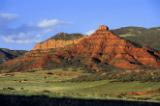Open Space 101
What Is Open Space?
“Open space” lacks a consistent definition, but the phrase generally refers to land that is undeveloped or lightly developed for uses other than agriculture. The State of New York offers a useful and inclusive definition of open space:
Open Space is land that is not intensively developed for residential, commercial, industrial or institutional use. It serves many purposes, whether it is publicly or privately owned. It includes agricultural and forest land, undeveloped shorelines, undeveloped scenic lands, public parks and preserves. It also includes water bodies such as lakes and bays. What is defined as open space depends in part on its surroundings. A vacant lot, community garden or small marsh can be open space in a big city. A narrow corridor or pathway for walking or bicycling is open space even though it is surrounded by developed areas. Historic and archeological sites are often associated with significant open spaces and are a part of our common heritage.
Why Is It Important?
From panoramic western landscapes to urban pocket parks and from mountain to shore, open space is a cherished part of America’s national and local identities. Its ecological importance and ability to sustain our spirit have long been appreciated, but our understanding of the economic value of these lands and waters has been steadily increasing in recent years. Forests, rangelands, and other natural lands and working landscapes provide human society with a range of essential and fundamentally irreplaceable services, such as pure water, abundant wildlife, and a moderating influence on our changing climate.
How Is It At Risk?
At the same time, America’s rural, urban, and suburban open spaces are dwindling rapidly. Each year about two million acres of open space are converted to other uses -- an amount that equals almost 6,000 acres a day -- and most of this conversion happens close to where many people live. Layered on top of an existing panoply of threats -- development pressure, resource extraction, non-native invasive species, altered natural processes -- is the specter of climate change, whose stresses will likely exacerbate these other, more familiar hazards. What we need now to protect America’s open space is continued commitment, increased investment, and renewed hope for the future.
Where Is It Found?
Fortunately, awareness and action to protect open space has never been greater. Citizens, land trusts, and public agencies have rallied to protect many of America’s finest lands and waters through a variety of innovative conservation approaches. In addition, many local communities have programs to preserve open space for a variety of purposes, ranging from recreation to water quality to wildlife habitat.
One of the most auspicious aspects of open space planning is that for the most part it happens locally. Communities with the will and the grassroots involvement to protect land and other resources can do tremendous things. Communities with the will and the grassroots involvement to protect land and other resources can do tremendous things. As author Samuel Brody has noted, “Some of the most effective policy tools that can either threaten or protect ecosystems are in the hands of county officials, city councils, town boards, local planning staff, and general public rather than federal or regional agencies.”
Many people do not realize the power that local communities have to determine their own future. Indeed, a landmark Supreme Court decision in 1926 -- Village of Euclid, Ohio v. Ambler Realty Co. -- stated that “every community has the right to determine its own character and the nature of development within.” This right encompasses decisions of whether or not to grow, how to grow, and how to conserve open space and other resources that the community perceives as valuable.
As a result, local governments have the power to create land-use plans that control growth and development while directing development to locations where sewer, water, roads, and other public infrastructure are already available. This means that no community is required to follow the path of urban sprawl and exurban development, an approach that is expensive, wasteful of energy, and likely to fragment open space.
Yet conventional land-use planning has often not lived up to its potential. Planning expert Philip Berke has pointed out that
While land use planning is a potentially effective long-term solution to future ecological decline, research-based evidence indicates that existing land use plans are too weak to encourage development that recognizes ecological systems. In addition, public apathy and a lack of political will may also hamper conservation planning efforts. In fact, communities sometimes adopt public land use policies that unwittingly encourage loss.
Berke also points out the mismatch between the local scale at which communities do their planning and the “ecosystem” or “landscape” scales at which many ecological processes operate. Wide-ranging species in particular are unlikely to benefit from open space or land-use planning that occurs city-by-city or county-by-county. One key to resolving this dilemma is greater interaction among local planners, conservation biologists, and ecologists, which can enhance communities’ capacity to view and place themselves within the broader regional context (Noss 2007). Also crucial is the use of the best available planning data, which can often separate perceived conflicts from real conflicts (Stein 2007).
More About Open Space
Go Straight to Your State
Learn about conservation and open space in your state.



